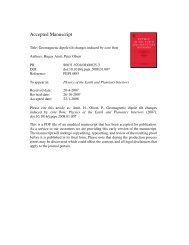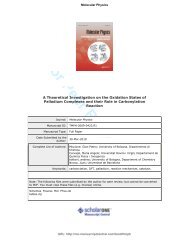An Analysis of Government Revenue and Expenditure in ... - TARA
An Analysis of Government Revenue and Expenditure in ... - TARA
An Analysis of Government Revenue and Expenditure in ... - TARA
You also want an ePaper? Increase the reach of your titles
YUMPU automatically turns print PDFs into web optimized ePapers that Google loves.
171<br />
follow from the correspondence between sav<strong>in</strong>gs <strong>and</strong> <strong>in</strong>vestments.*<br />
Sav<strong>in</strong>gs are postponed consumption while <strong>in</strong>vestment represents<br />
future expansion <strong>of</strong> capacity to consume. Yet on page 2 <strong>of</strong> the<br />
Irish Statistical Survey " attention is drawn to the fact that, for<br />
social account<strong>in</strong>g purposes, capital expenditure covers not only<br />
outlays on formation <strong>of</strong> assets promis<strong>in</strong>g future monetary returns<br />
or <strong>in</strong>creases <strong>in</strong> national <strong>in</strong>come but also outlays on <strong>in</strong>vestment<br />
designed to provide non-monetary benefits to the whole community<br />
"t (italics m<strong>in</strong>e).<br />
It seems to me that there is an <strong>in</strong>consistancy between this statement,<br />
which I believe to be correct on its own, <strong>and</strong> the identity<br />
between national expenditure <strong>and</strong> national <strong>in</strong>come. Unless this<br />
<strong>in</strong>consistancy is unreal, due to some k<strong>in</strong>d <strong>of</strong> an optical illusion on<br />
my part, one <strong>of</strong> the follow<strong>in</strong>g three th<strong>in</strong>gs appear <strong>in</strong>escapable :—<br />
(1) the concept <strong>of</strong> national <strong>in</strong>come must be enlarged to <strong>in</strong>clude<br />
all the future returns expected from public capital outlays;<br />
or<br />
(2) the dist<strong>in</strong>ction between current <strong>and</strong> capital expenditures for<br />
national <strong>in</strong>come purposes must be dropped s<strong>in</strong>ce it has been<br />
violated by the <strong>in</strong>clusion, as capital, <strong>of</strong> expenditures which<br />
do not carry the expectation <strong>of</strong> future returns <strong>in</strong> goods <strong>and</strong><br />
services constitut<strong>in</strong>g national <strong>in</strong>come; or<br />
(3) public capital outlays which promise a future return other<br />
than goods <strong>and</strong> services which enter <strong>in</strong>to the calculation <strong>of</strong><br />
national <strong>in</strong>come must be treated as current expenditures.<br />
I suggest that the third course is the obvious one to follow. The<br />
really dist<strong>in</strong>guish<strong>in</strong>g feature <strong>of</strong> <strong>in</strong>vestment is that it is a means to<br />
an end <strong>and</strong> not an end <strong>in</strong> itself <strong>and</strong> to some extent public capital<br />
outlays evidently serve primarily a social end. The fact that <strong>in</strong><br />
satisfy<strong>in</strong>g the social end they may also <strong>in</strong>crease the flow <strong>of</strong> goods<br />
<strong>and</strong> services <strong>in</strong> the future, is, I admit, a complication requir<strong>in</strong>g<br />
an arbitrary convention, which would however be only an extension<br />
<strong>of</strong> a similar convention applied <strong>in</strong> the private sector. A glance at<br />
the operat<strong>in</strong>g expenses <strong>of</strong> any private undertak<strong>in</strong>g would afford<br />
many examples <strong>of</strong> expenses wholly treated as current despite the<br />
fact that they are likely to <strong>in</strong>crease the undertak<strong>in</strong>g's future pr<strong>of</strong>its.<br />
*cf. Irish Statistical Survey, 1958 :—•<br />
" The sav<strong>in</strong>gs <strong>of</strong> persons, public authorities <strong>and</strong> companies together with<br />
provision for depreciation <strong>and</strong> net foreign dis<strong>in</strong>vestment are used to f<strong>in</strong>ance<br />
domestic capital formation.<br />
In Table A. 7 gross domestic physical capital formation is equated to the<br />
total amount available for <strong>in</strong>vestment."<br />
I agree that the Keynesian identity between sav<strong>in</strong>gs <strong>and</strong> <strong>in</strong>vestment does<br />
appear to be at variance with the undeniable economic fact that part <strong>of</strong> the funds<br />
go<strong>in</strong>g <strong>in</strong>to <strong>in</strong>vestment is <strong>of</strong>ten f<strong>in</strong>anced from bank credit or from idle balancey,<br />
<strong>and</strong> contrariwise, that sav<strong>in</strong>gs (e.g. external dis<strong>in</strong>vestment) are <strong>of</strong>ten used to<br />
f<strong>in</strong>ance consumption. This, however, does not help much, because <strong>in</strong> our statistics<br />
<strong>of</strong> national <strong>in</strong>come this correspondence between sav<strong>in</strong>gs <strong>and</strong> <strong>in</strong>vestment is<br />
explicitly assumed.<br />
fI wish to thank Mr. Broderick for acknowledg<strong>in</strong>g my part <strong>in</strong> this def<strong>in</strong>ition<br />
<strong>of</strong> public capital outlays which are <strong>in</strong>cluded <strong>in</strong> national expenditures. The<br />
difficulty, however, does not lie <strong>in</strong> this def<strong>in</strong>ition (which, as he stated, is correct)<br />
but <strong>in</strong> its reconciliation with the threefold identity between national <strong>in</strong>come =<br />
national product = national expenditure (with which I had noth<strong>in</strong>g to do).
















